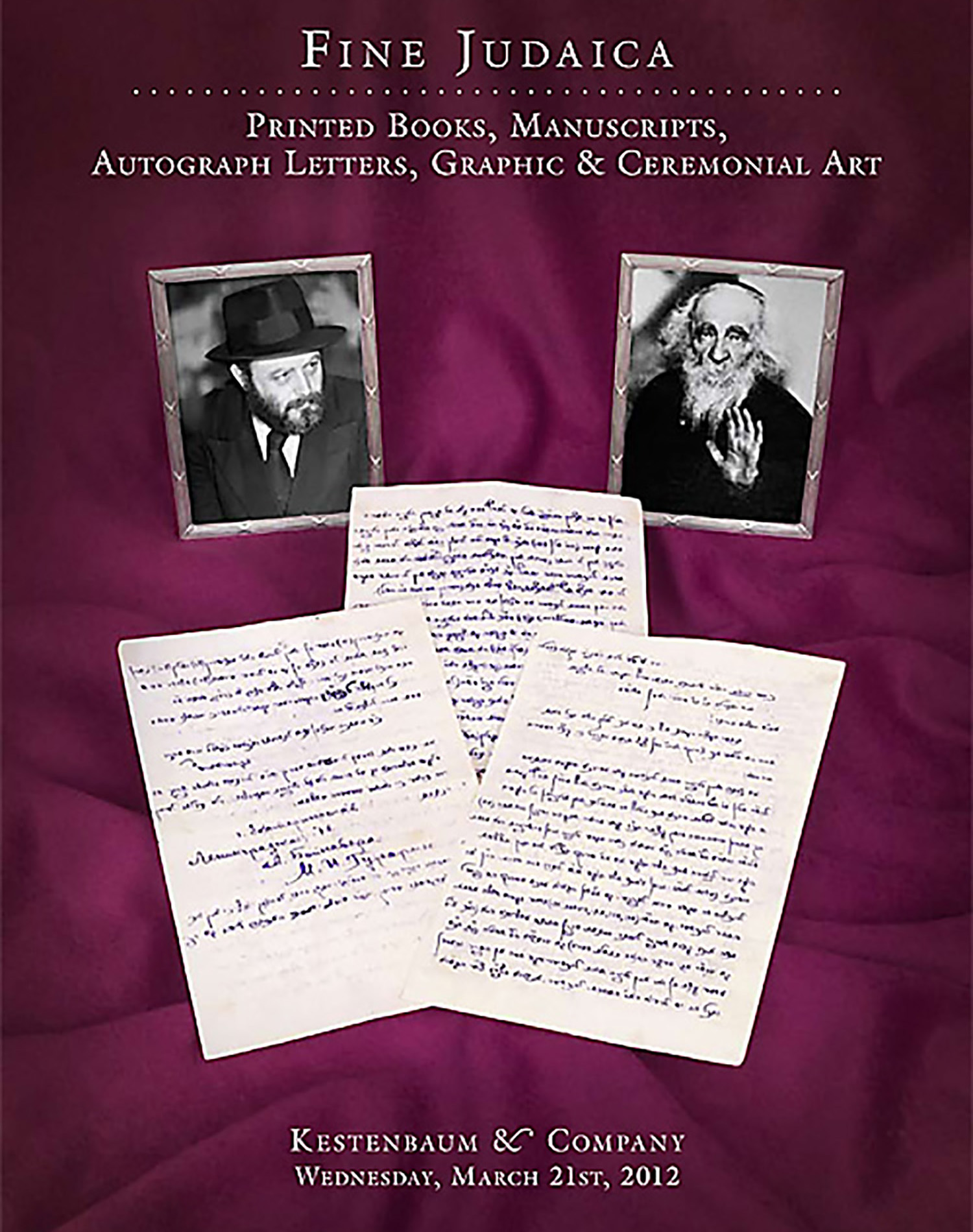(1902-1994. Seventh Grand Rabbi of Lubavitch). Autograph Letter Signed in purple ink, written in Hebrew to Rabbi Yoseph Rosen “the Rogatchover Gaon.”

AUCTION 54 |
Wednesday, March 21st,
2012 at 1:00
Fine Judaica: Printed Books, Manuscripts Autograph Letters, Graphic & Ceremonial Art
Lot 284
SCHNEERSON, MENACHEM MENDEL.
(1902-1994. Seventh Grand Rabbi of Lubavitch). Autograph Letter Signed in purple ink, written in Hebrew to Rabbi Yoseph Rosen “the Rogatchover Gaon.”
Yekatrinaslov (Dnipropetrovsk): 15th Teveth 1925
Est: $30,000 - $50,000
PRICE REALIZED $30,000
<<THE VERY EARLIEST EXISITING AUTOGRAPH LETTER WRITTEN BY THE LUBAVITCHER REBBE.>> <<A LENGTHY AND VERY LEARNED LETTER TO THE GREAT ROGATCHOVER GAON COMPOSED BY THE YOUNG R. MENACHEM MENDEL SCHNEERSON IN THE SOVIET WINTER OF 1925.>>
Written from the Rebbe’s hometown of Yekaterinoslav, the letter displays extraordinary erudition, an elegant style and much confidence, as this young man of just 23 years of age corresponds in learning with the Rogatchover Gaon, the foremost Talmudic genius of his time and more than four decades the young man’s senior.
The primary subject of this cerebral and polished letter is Treifus. The matter turning on the issue that should a cow possess a cavity in one of its organs, then the animal may no longer be regarded as suitably kosher for consumption. Moreover, the Rogatchover’s position is that such a status can never be changed. The Rebbe here seeks to prove otherwise, in that should the sickly animal be successfully operated upon and subsequently the animal’s organ was now entirely sealed and healthy again, then the status of ‘treif’ is nullified and the animal may revert to being regarded as fully kosher.
The letter displays remarkable fluency in learning, offering over forty rabbinic texts as references, supplying a penetrating analysis of an esoteric topic. Towards the end of this three page letter, the Rebbe reminds the Rogatchover concerning his query in a prior letter, seeking a source for the practice of writing at the commencement of correspondences the initial Hebrew letters B”H (Baruch Hashem) or BE”H (B’Ezrath Hashem). The Rebbe respectfully states he is surprised that he has not as yet received a reply. Finally and most interestingly, the Rebbe pseudonymously signs the letter “Mordechai Gurary of Yekaterinoslav.” Many decades later, when this letter became available and Rabbi Sholom-Ber Levin, the editor of the Igroth Kodesh, was preparing it for publication, the Rebbe was asked for an explanation for this. “To hide the name Schneerson from the Russian censor” was the Rebbe’s response. (As an intriguing side-note, in 1931 Yisrael Aryeh Leib Schneerson, the Rebbe’s youngest brother, adopted the name Mark Gurary in order to procure false papers and flee the Soviet Union).
Issued by the Kehot Publication Society, the multi-volume Igroth Kodesh records two other letters that the Rebbe wrote to the Rogatchover following the present one: A second from 1928 and a third written in 1932. One might assume there was further correspondence, but none has survived.
Rabbi Yoseph Rosen (1858-1936), known as “the Rogatchover” after his birthplace of Rogatchov, Belarus, was endowed with both a photographic memory and a deeply penetrating philosophical mind that gave him a remarkable ability for original, analytic conceptualizations. Although the Rogatchover came from a background of Kopust Chassidim (a branch of Chabad stemming from a son of the Rebbe Mahara”sh), the Gaon himself was not formally a Chossid, and yet throughout his life, maintained close connections with the Lubavitcher leadership. In turn, the future Rebbe, R. Menachem Mendel, was greatly enamored by the Rogatchover’s brilliance and cited him innumerable times in his public discourses over many decades.
Russian-born R. Menachem Mendel Schneerson was taken to Yekaterinoslav, Ukraine, aged five, after his father, R. Levi Yitzchak Schneerson, was appointed district Rabbi. While growing up there, R. Menachem Mendel’s education was entirely privately received.
For a tremendously energetic and innovative Jewish leader who grew to become an international icon across the second half of the 20th-century, comparatively little is publicly known about the Rebbe’s youth.
At the time this letter was written, the Rebbe was somewhat isolated within the Soviet Union and little known beyond its borders. Thus, it is a revelation to experience here the supremely confident style in which the young man writes to the universally renowned great Gaon, the Rogatchover. We might know little else about him at this particular time of his life, however, aged 23 (and not formally schooled, but mostly self-taught) the Rebbe was clearly, an outstanding Talmid-Chocham and this letter is more than enough to display the young man’s brilliance in Torah.
Thousands of letters are known to have been written by the Rebbe, almost 12,000 of which, of a more public nature, have been published to date. Certainly a far, far greater quantity of letters are those the Rebbe wrote on a personal level to countless numbers of Chassidim, followers and petitioners from the most diverse of communities across the globe. These letters are kept by the recipient for a lifetime due to the direct relationship with the Rebbe such a letter may bring.
Hence the majesty of the present letter. This is the very first such letter that exists that would subsequently be followed by an avalanche of others, over six and a half decades: Letters displaying the Rebbe’s wisdom, care, instruction, guidance and counsel. Of all these letters, the present one is the very earliest known.
See M.M. Laufer, Yemei Melech (1989) pp. 167-77, Igroth Kodesh, Vol. XXI (1993) pp.1-6; Sepher Siyumei HaRambam (1989) pp. 23-5.
<<The oldest surviving letter written by the Lubavitcher Rebbe. Of meaningful content and sent to an individual, the Rogatchover Gaon, who would be of significance to the Rebbe for his entire life.>>
